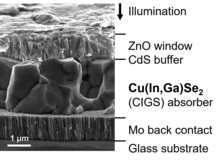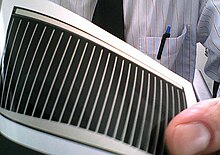User:H.Kempa/Thin-film solar cell
Copper indium gallium selenide (CIGS)[edit]
| Cell | Module | |
| Glass substrate | 23.6 %[1] | 20.3 %[2] |
| Flexible substrate | 22.2 %[3] | 18.6 %[4] |
Like CdTe, copper indium gallium selenide (CIGS) and its variations are chalcogenide compound semiconductors. CIGS solar cells reached a lab-efficiency above 23 percent (see table) and a share of 0.8 percent in the overall PV market in 2021[5]. Numerous companies have produced CIGS solar cells and modules, however, some of them have significantly reduced or ceased production during the last years.

Actual research aims at improving properties related to fabrication and functionality by modifying or replacing the individual layers, for example:
- Alternative materials are investigated to replace cadmium sulfide as a buffer layer due to its hazard potential.
- Molybdenium as a back contact is replaced by a transparent conducting film in order to obtain bifacial solar cells.

- CIGS solar cells show a particularly low loss in efficiency, when deposited on a flexible substrate instead of glass (see table), hence they are considered promising candidates for bendable and lightweight solar modules[6].
Apart from the development potential of the other layers in the solar cell, the absorber material CIGS has the remarkable property, that its band gap can be tuned by adjusting the ratio of indium and gallium in the compound. By tuning the band gap, the fraction of the solar spectrum which is absorbed by the solar cell can be changed, making CIGS cells especially interesting as constituents of multi-junction solar cells[6].
It is also possible to partially replace copper by silver and selenium by sulfur yielding the compound (AgzCu1-z)(In1-xGax)(Se1-ySy)2. In order to distinguish the sulfur-free compound, it is sometimes abbrievated CIGSe, while the acronym CIGS can refer to both sulfur and selenium containing compounds. The silver containing compound is sometimes referred to as ACIGS. Variations of the CIGS composition are subject to current research and in part also fabricated in industry.
Cite error: There are <ref> tags on this page without content in them (see the help page).
- ^ Green, M. A.; et al. (2023). "Solar cell efficiency tables (version 62)". Progress in Photovoltaics. 31: 651–663. doi:10.1002/pip.3726.
- ^ "Press release" (PDF). AVANCIS GmbH.
- ^ "Flexible Solarzellen mit Rekordwirkungsgrad von 22,2%". Empa.
- ^ "Large Area Flexible PV Modules Show Equivalent c-Si Performance". MiaSolé.
- ^ "Photovoltaics report" (PDF). Fraunhofer Institute for Solar Energy Systems (ISE).
- ^ a b "CIGS White Paper" (PDF). Zentrum für Sonnenenergie- und Wasserstoff-Forschung Baden-Württemberg (ZSW).
